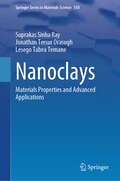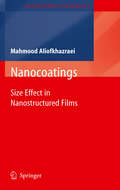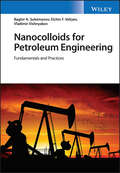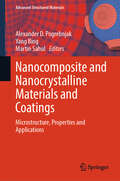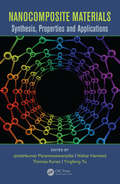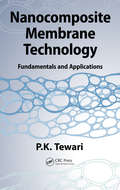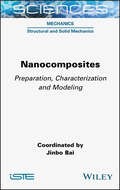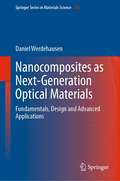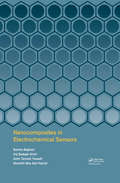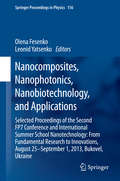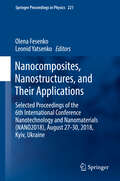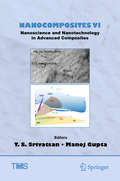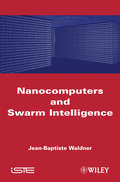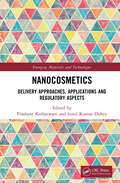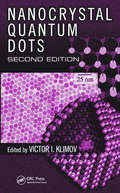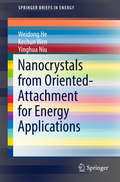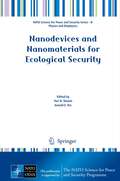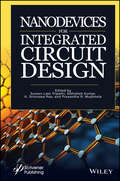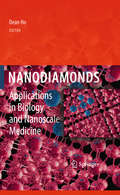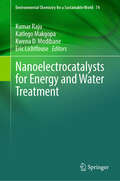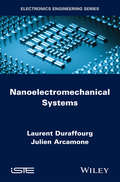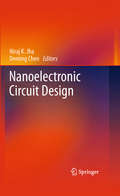- Table View
- List View
Nanoclays: Materials Properties and Advanced Applications (Springer Series in Materials Science #350)
by Suprakas Sinha Ray Jonathan Tersur Orasugh Lesego Tabea TemaneThis book covers natural and synthetic nanoclays, focusing on the fundamentals of nanoclay-chemistry and applications in advanced technologies. For millennia, clay has been an indispensable part of human civilization, playing an especially fundamental role in modern society in the form of e.g. porcelain, ceramics, bricks, and tiles, as well as being an essential constituent for plastics, paints, paper, rubber, cosmetics, sensors, and medicinal products.The book introduces the reader to nanoclays, most commonly referred to as layered silicates, which take the form of layered or sheet-like structures with nanometer-scale dimensions. It describes the structure and materials properties of both natural and synthetic nanoclays, and covers their applications in diverse areas such as paint formulations, water purification, cosmetics, biomedical applications, and energy storage. Authored by experts with long-standing experience in industry and academic research, this book serves as a useful reference not only for students and academics interested in this exciting new field, but also industrial researchers and R&D managers wishing to bring nanoclay-based advanced products to market.
Nanocoatings
by Mahmood AliofkhazraeiSize effect in structures has been taken into consideration over the last years. In comparison with coatings with micrometer-ranged thickness, nanostructured coatings usually enjoy better and appropriate properties, such as strength and resistance. These coatings enjoy unique magnetic properties and are used with the aim of producing surfaces resistant against erosion, lubricant system, cutting tools, manufacturing hardened sporadic alloys, being resistant against oxidation and corrosion. This book reviews researches on fabrication and classification of nanostructured coatings with focus on size effect in nanometric scale. Size effect on electrochemical, mechanical and physical properties of nanocoatings are presented.
Nanocolloids for Petroleum Engineering: Fundamentals and Practices
by Baghir A. Suleimanov Elchin F. Veliyev Vladimir VishnyakovNanocolloids for Petroleum Engineering Enables readers to understand nanocolloids in upstream operations in the oil industry from an applied and theoretical point of view Nanocolloids for Petroleum Engineering brings together the background, latest advances, and practical and theoretical information about nanocolloids for petroleum engineering in one comprehensive volume. The text is structured in such a way to allow readers to easily distinguish key points and quickly gain the expertise they need to become more effective in their respective disciplines. For practical purposes and to aid in seamless reader comprehension, experiences of service companies, general guidance, and problem solving exercises are included throughout the text. The highly qualified authors specifically present the subject as petroleum experts and use a niche industry point of view, which means petroleum, reservoir, and drilling engineers will be able to quickly understand and digest the information contained within. Sample topics covered in the work include: A brief introduction to and classification of colloid systems, describing the main properties of nanocolloids crucial for practical application in petroleum engineering Nanocolloids application in reservoir engineering and development, illustrating reservoir conditions necessary for nanocolloids formation Nanocolloid applications in production operations, including the mechanism of nanoscale dispersion phase impact on physical properties of conventional substances utilized in upstream processes Nanocolloid application in Enhanced Oil Recovery (EOR) and the impact of nanoparticles on conventional displacement agents Nanocolloids for Petroleum Engineering serves as a comprehensive reference work and standalone guide for petroleum engineers who are interested in gaining knowledge surrounding nanocolloids and harnessing that knowledge to aid in solving a wide variety of conventional challenges in the field.
Nanocomposite and Nanocrystalline Materials and Coatings: Microstructure, Properties and Applications (Advanced Structured Materials #214)
by Alexander D. Pogrebnjak Yang Bing Martin SahulThis book is a collection of reports (reviewed) selected from several sections of the IEEE Nanomaterials: Application and Properties-2023 conference. The book is devoted to the study of films, coatings, and materials obtained by various methods of preparation and deposition, for example, magnetron sputtering of targets, vacuum arc deposition , electron-plasma processing, sintering of composites, plasma jet deposition, and other methods for obtaining nanomaterials. The chapters and reports describe superhard coatings, spark, and plasma alloying of materials (metals, semiconductors, polymers, ceramics).
Nanocomposite Materials: Synthesis, Properties and Applications (Woodhead Publishing Series In Composites Science And Engineering Ser.)
by Jyotishkumar Parameswaranpillai Nishar Hameed Thomas Kurian Yingfeng YuThis book provides a comprehensive collection of the latest information on nanomaterials and nanocomposites. It covers material synthesis, processing, structure characterization, properties and applications. It presents a coherent treatment of how composite properties depend on nanostructure, and covers cutting-edge topics like bionanocomposites for sustainable development. This book summarizes many developments in the field making it an ideal resource for researchers from industry, academia, government and private research institutions.
Nanocomposite Membrane Technology: Fundamentals and Applications
by P.K. TewariNanocomposite Membrane Technology: Fundamentals and Applications is the first book to deliver an extensive exploration of nanocomposite membrane technology. This groundbreaking text offers an eloquent introduction to the field as well as a comprehensive overview of fundamental aspects and application areas. Approaching the subject from the material
Nanocomposites: Preparation, Characterization and Modeling
by Jinbo BaiNanocomposites are one of the major advances in the field of materials. They have applications in sectors as varied as aeronautics, energy and the environment. However, the effective use of nanocomposites requires new knowledge and tools in order to overcome the difficulties and benefit from the advantages. Nanocomposites presents recent academic and industrial progress in this field, as well as the latest research on the effective use of nanoscale fillers and reinforcements to improve the performance of advanced nanocomposites. It also describes the techniques and tools used to prepare nanocomposites, including the latest techniques for synthesis and surface treatment of nanofillers for different applications. Finally, it details the role of nanoscience in the design, characterization and multi-scale modeling of these materials, with a focus on nanoscale phenomena.
Nanocomposites as Next-Generation Optical Materials: Fundamentals, Design and Advanced Applications (Springer Series in Materials Science #316)
by Daniel WerdehausenThis book looks at advanced nanocomposites, introducing long-awaited concepts towards bridging the gap between nanostructured optical materials and next-generation imaging systems. It investigates nanocomposites as bulk optical materials and highlights the immense potential they hold for real-world optical elements and systems, such as smartphone cameras. It covers the full spectrum of nanocomposite optical materials from their fundamental properties to analytical modeling and detailed application examples. This book also provides an in-depth discussion of the role these new materials play in the development of broadband flat optics – diffractive optical elements used for enhancing high-end broadband imaging systems. Written by an industry expert, this book seamlessly connects fundamental research and real-world applications. It is the ideal guide both for optical engineers working towards integrating new technologies, and researchers involved with fundamental research on optical materials.
Nanocomposites in Electrochemical Sensors
by Samira Bagheri Iraj Sadegh Amiri Amin Termeh Yousefi Sharifah Bee Abd HamidNanotechnology has become one of the most important fields in science. Nanoparticles exhibit unique chemical, physical and electronic properties that are different from those of bulk materials, due to their small size and better architecture. Nanoparticles can be used to construct novel sensing devices; in particular electrochemical sensors. Electrochemical detection is highly attractive for the monitoring of glucose, cancer cells, cholesterol and infectious diseases. Unique nanocomposite-based films proposed in this book open new doors to the design and fabrication of high-performance electrochemical sensors.
Nanocomposites, Nanophotonics, Nanobiotechnology, and Applications
by Olena Fesenko Leonid YatsenkoThis book presents some of the latest achievements in nanotechnology and nanomaterials from leading researchers in Ukraine, Europe, and beyond. It features contributions from participants in the 2nd International Summer School "Nanotechnology: From Fundamental Research to Innovations" and International Research and Practice Conference "Nanotechnology and Nanomaterials", NANO-2013, which were held in Bukovel, Ukraine on August 25-September 1, 2013. These events took place within the framework of the European Commission FP7 project Nanotwinning, and were organized jointly by the Institute of Physics of the National Academy of Sciences of Ukraine, University of Tartu (Estonia), University of Turin (Italy), and Pierre and Marie Curie University (France). Internationally recognized experts from a wide range of universities and research institutions share their knowledge and key results on topics ranging from nanooptics, nanoplasmonics, and interface studies to energy storage and biomedical applications.
Nanocomposites, Nanostructures, and Their Applications: Selected Proceedings of the 6th International Conference Nanotechnology and Nanomaterials (NANO2018), August 27-30, 2018, Kyiv, Ukraine (Springer Proceedings in Physics #221)
by Olena Fesenko Leonid YatsenkoThis book highlights some of the latest advances in nanotechnology and nanomaterials from leading researchers in Ukraine, Europe, and beyond. It features contributions from participants in the 6th International Science and Practice Conference Nanotechnology and Nanomaterials (NANO2018) in Kiev, Ukraine on August 27-30, 2018 organized by the Institute of Physics of the National Academy of Sciences of Ukraine, University of Tartu (Estonia), University of Turin (Italy), and Pierre and Marie Curie University (France). Internationally recognized experts from a wide range of universities and research institutions share their knowledge and key results on material properties, behavior, and synthesis. This book's companion volume also addresses topics such as nanooptics, energy storage, and biomedical applications.
Nanocomposites VI: Nanoscience and Nanotechnology in Advanced Composites (The Minerals, Metals & Materials Series)
by Manoj Gupta T. S. SrivatsanThis volume presents novel and innovative contributions in the domain specific to nanocomposites, specifically on aspects both related and relevant to the following: · science at the nanoscale level · innovations and advances in processing · characterization, quantification, and analysis · mechanical property evaluation and rationalization · failure analysis · technological applications at the nanoscale level The collection brings together a range of developments in areas spanning basic science, processing, analysis, characterization, mechanical property evaluation, and failure analysis rationalization of composite materials.
Nanocomputers and Swarm Intelligence
by Jean-Baptiste WaldnerFor the last 50 years, the power of integrated circuits has continued to grow. However, this performance will end up reaching its physical limit. What new ways will then be available to develop even more powerful and up-to-date systems? This book introduces the principles of quantic computing, the use of nano-tubes in molecular transistors and ADN computing. It suggests new fabrication methods for the 21st century and introduces new architecture models, ranging from the most conventional to the most radical. Using a chronological theme, it explains our unavoidable entry in the nano-device world: from the 1948 transistor to the microchip. It concludes by anticipating the changes in daily living: investments, impact on coding activities, nanocomputing systems implementation and IT job mutation.
Nanocosmetics Delivery Approaches, Applications and Regulatory Aspects: Delivery Approaches, Applications And Regulatory Aspects (Emerging Materials and Technologies)
by Prashant Kesharwani Sunil Kumar DubeyThis book offers an overview of the science of cosmetics and the formulation of nanosized cosmetic products including fabrication, characterization of nanocosmetics, major challenges in the safe applications, regulatory aspects, and commercialization on a large scale. The chapters provide understanding of the interaction of nanocarriers with skin and hair, different nanocosmetic products in the present situation, applications as well as disadvantageous toxicity associated with nanocosmetics, regulatory prospects, and future perspectives. Features: Provide an explicit account on vital aspects of various nanocosmetics drug delivery approaches, thereby providing a next-generation cosmetic product. Bring together the novel applications of nanocosmetics approaches in the biological milieu. Explores preparation, applications, toxicity, and regulatory prospects. Includes a dedicated chapter on Niosomal drug-delivery systems in cosmetics. Discusses the perspectives of the technologies explored so far based upon the findings outlined in highly organized tables, illustrative figures, and flow charts. This book is aimed at researchers and professionals in nanomedicine, pharmaceuticals, biotechnology, and the health sector.
Nanocrystal Quantum Dots
by Victor I. KlimovA review of recent advancements in colloidal nanocrystals and quantum-confined nanostructures, Nanocrystal Quantum Dots is the second edition of Semiconductor and Metal Nanocrystals: Synthesis and Electronic and Optical Properties, originally published in 2003. This new title reflects the book’s altered focus on semiconductor nanocrystals. Gathering contributions from leading researchers, this book contains new chapters on carrier multiplication (generation of multiexcitons by single photons), doping of semiconductor nanocrystals, and applications of nanocrystals in biology. Other updates include: New insights regarding the underlying mechanisms supporting colloidal nanocrystal growth A revised general overview of multiexciton phenomena, including spectral and dynamical signatures of multiexcitons in transient absorption and photoluminescence Analysis of nanocrystal-specific features of multiexciton recombination A review of the status of new field of carrier multiplication Expanded coverage of theory, covering the regime of high-charge densities New results on quantum dots of lead chalcogenides, with a focus studies of carrier multiplication and the latest results regarding Schottky junction solar cells Presents useful examples to illustrate applications of nanocrystals in biological labeling, imaging, and diagnostics The book also includes a review of recent progress made in biological applications of colloidal nanocrystals, as well as a comparative analysis of the advantages and limitations of techniques for preparing biocompatible quantum dots. The authors summarize the latest developments in the synthesis and understanding of magnetically doped semiconductor nanocrystals, and they present a detailed discussion of issues related to the synthesis, magneto-optics, and photoluminescence of doped colloidal nanocrystals as well. A valuable addition to the pantheon of literature in the field of nanoscience, this book presents pioneering research from experts whose work has led to the numerous advances of the past several years.
Nanocrystals from Oriented-Attachment for Energy Applications (SpringerBriefs in Energy)
by Weidong He Kechun Wen Yinghua NiuThis brief provides a comprehensive overview of contemporary research and materials technologies utilizing oriented-attachment nanocrystals (OA NCs) for the energy conversion devices. Starting with a historical introduction, the book presents basic theory with an emphasis on thermodynamic and kinetic models of the oriented-attachment nanocrystals growth. Further chapters review recent advances in the synthesis, characterization, and application of the oriented-attachment nanocrystals in fuel cells, batteries, supercapacitors, solar cells and photocatalysis. This book will appeal to researchers and scholars from a variety of disciplines including electrochemistry, materials science, chemical engineering, physics and mechanical engineering.
Nanodevices and Nanomaterials for Ecological Security
by Arnold E. Kiv Yuri N. ShuninThis book is devoted to a wide range of problems concerning applications of nanomaterials and nanodevices as effective solutions to modern ecological problems. Leading experts in nanoscience and nanotechnology present the key theoretical, experimental and implementation issues related to the creation and utilization of novel nanoscale devices to help ensure ecological security. The authors discuss appropriate nanotechnologies for minimizing various types of risk: to human life, technogenic risk, or indeed terrorist threats. Particular emphasis is placed on defining and studying the required materials properties, and - in the field - on nanoscale devices for sensors and monitoring.
Nanodevices for Integrated Circuit Design
by Suman Lata TripathiNANODEVICES FOR INTEGRATED CIRCUIT DESIGN Nanodevices are an integral part of many of the technologies that we use every day. It is a constantly changing and evolving area, with new materials, processes, and applications coming online almost daily. Increasing demand for smart and intelligent devices in human life with better sensing, communication and signal processing is increasingly pushing researchers and designers towards future design challenges based upon internet-of-things (IoT) applications. Several types of research have been done at the level of solid-state devices, circuits, and materials to optimize system performance with low power consumption. For suitable IoT-based systems, there are some key areas, such as the design of energy storage devices, energy harvesters, novel low power high-speed devices, and circuits. Uses of new materials for different purposes, such as semiconductors, metals, and insulators in different parts of devices, circuits, and energy sources, also play a significant role in smart applications of such systems. Emerging techniques like machine learning and artificial intelligence are also becoming a part of the latest developments in an electronic device and circuit design. This groundbreaking new book will, among other things, aid developing countries in updating their semiconductor industries in terms of IC design and manufacturing to avoid dependency on other countries. Likewise, as an introduction to the area for the new-hire or student, and as a reference for the veteran engineer in the field, it will be helpful for more developed countries in their pursuit of better IC design. It is a must have for any engineer, scientist, or other industry professional working in this area.
Nanodiamonds
by Dean HoNanodiamonds: Applications in Biology and Nanoscale Medicine highlights the translation of nanodiamonds toward clinical relevance and medical applications. Integrating a spectrum of internationally-recognized experts currently developing these technologies, this book fits as a cornerstone of this exciting field. These include contributions from clinician scientists working at the interface of medicine and nanotechnologies which discuss the critical and requisite properties of nanomaterials, in a concise and cohesive manner. Nanodiamonds: Applications in Biology and Nanoscale Medicine provides a multidisciplinary overview of nanodiamonds and there uses for scientific, engineering and clinical audiences alike.
Nanodroplets
by Zhiming M. WangNanodroplets, the basis of complex and advanced nanostructures such as quantum rings, quantum dots and quantum dot clusters for future electronic and optoelectronic materials and devices, have attracted the interdisciplinary interest of chemists, physicists and engineers. This book combines experimental and theoretical analyses of nanosized droplets which reveal many attractive properties. Coverage includes nanodroplet synthesis, structure, unique behaviors and their nanofabrication, including chapters on focused ion beam, atomic force microscopy, molecular beam epitaxy and the "vapor-liquid- solid" route. Particular emphasis is given to the behavior of metallic nanodroplets, water nanodroplets and nanodroplets in polymer and metamaterial nanocomposites. The contributions of leading scientists and their research groups will provide readers with deeper insight into the chemical and physical mechanisms, properties, and potential applications of various nanodroplets.
Nanoelectrocatalysts for Energy and Water Treatment (Environmental Chemistry for a Sustainable World #74)
by Eric Lichtfouse Kumar Raju Katlego Makgopa Kwena D. ModibaneNanomaterials have recently garnered significant attention and practical importance for heterogeneous electrocatalysis. This book presents recent developments in the design, synthesis, and characterisation of nanostructured electrocatalytic materials, with a focus on applications to energy and wastewater treatment. Electrocatalytic nanomaterials can enhance process efficiency and sustainability, thus providing innovative solutions for a wide array of areas such as sustainable energy production, conversion, and wastewater treatment. Readers will gain insights into the latest breakthroughs in electrocatalysis and the activity of nanomaterials in energy conversion applications, e.g., fuel cells, hydrogen production, water splitting, and electro/photocatalytic water splitting, as well as for wastewater treatment. The book explores the development of advanced electrocatalysts, particularly hybrid materials.
Nanoelectrochemistry
by Michael V. Mirkin Shigeru AmemiyaNanoscale electrochemistry has revolutionized electrochemical research and technologies and has made broad impacts in other fields, including nanotechnology and nanoscience, biology, and materials chemistry. Nanoelectrochemistry examines well-established concepts and principles and provides an updated overview of the field and its applications.This
Nanoelectromechanical Systems
by Julien Arcamone Laurent DuraffourgThis book will present the theoretical and technological elements of nanosystems. Among the different topics discussed, the authors include the electromechanical properties of NEMS, the scaling effects that give these their interesting properties for different applications and the current manufacturing processes. The authors aim to provide useful tools for future readers and will provide an accurate picture of current and future research in the field.
Nanoelectromechanics in Engineering and Biology (Nano- and Microscience, Engineering, Technology and Medicine)
by Michael Pycraft HughesThe success, growth, and virtually limitless applications of nanotechnology depend upon our ability to manipulate nanoscale objects, which in turn depends upon developing new insights into the interactions of electric fields, nanoparticles, and the molecules that surround them. In the first book to unite and directly address particle electrokinetics and nanotechnology, Nanoelectromechanics in Engineering and Biology provides a thorough grounding in the phenomena associated with nanoscale particle manipulation. The author delivers a wealth of application and background knowledge, from using electric fields for particle sorting in lab-on-a-chip devices to electrode fabrication, electric field simulation, and computer analysis. It also explores how electromechanics can be applied to sorting DNA molecules, examining viruses, constructing electronic devices with carbon nanotubes, and actuating nanoscale electric motors. The field of nanotechnology is inherently multidisciplinary-in its principles, in its techniques, and in its applications-and meeting its current and future challenges will require the kind of approach reflected in this book. Unmatched in its scope, Nanoelectromechanics in Engineering and Biology offers an outstanding opportunity for people in all areas of research and technology to explore the use and precise manipulation of nanoscale structures.
Nanoelectronic Circuit Design
by Niraj K. Jha Deming ChenThis book is about large-scale electronic circuits design driven by nanotechnology, where nanotechnology is broadly defined as building circuits using nanoscale devices that are either implemented with nanomaterials (e.g., nanotubes or nanowires) or following an unconventional method (e.g., FinFET or III/V compound-based devices). These nanoscale devices have significant potential to revolutionize the fabrication and integration of electronic systems and scale beyond the perceived scaling limitations of traditional CMOS. While innovations in nanotechnology originate at the individual device level, realizing the true impact of electronic systems demands that these device-level capabilities be translated into system-level benefits. This is the first book to focus on nanoscale circuits and their design issues, bridging the existing gap between nanodevice research and nanosystem design.
